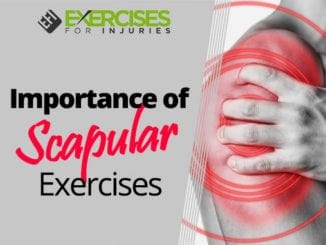
I went to the weight room and did a workout yesterday. While in there, someone caught my eye. It was a person performing rotator cuff exercise mistake.
As I went from exercise to exercise, he went from rotator cuff to rotator cuff exercise. Everything he did, in my mind, I was saying why he should not be doing that.
Let me share with you what my mind was saying as this patron was doing things to injure his rotator cuff and how he could tweak stuff so he is helping his rotator cuff.
#1 – Start with the Right Kind of Warm-Up
He should have taken 5 minutes and warmed up the upper body and rotator cuff. I am not talking about going on the treadmill and walking for 5 minutes. I am talking about a warm-up targeting the upper body.
An example of an upper-body warm-up that he could have done before he got into his rotator cuff exercises is:
- Jump Rope – 2 minutes
- Push-Ups – 10 repetitions
- Shoulder Bridges – 10 repetitions
- Tubing Face Pulls – 10 repetitions
- Thread the Needle – 10 repetitions
These exercises warm the shoulder, activate the muscle in the shoulder blade area (scapular muscles) and improve mid-back mobility, decreasing the stress on the rotator cuff.
If you have Muscle Imbalances Revealed – Upper Body Edition – Josh Saunders goes through a tremendous upper body dynamic warm-up that he does for his boot campers.
#2 – Doing WAY too Many Scapular Exercises
I will pass on writing about this and let myself explain things in this video:
#3 – Stop Doing the Wrong Stretches Between Sets
It is common to see people stretching after they do an exercise. For example, you would know the person stretched out their chest after doing a bench press.
Does this help or make things worse for the rotator cuff?
I would say it hurts the rotator cuff and decreases your performance. He should have stretched the antagonist muscle (the muscle group performing the opposite action or movement).
For example, if you are working the back by doing a rowing exercise, after the workout, you would stretch out the antagonist, which is the chest. Doing this will help decrease tension in the chest, lengthen the chest muscles, and allows you to get a more excellent range of motion and less resistance from the chest muscles when performing the rowing exercise.
#4 – Don’t Make Your Rotator Cuff Weaker by “Strengthening” It
Doing too many rotator cuff exercises can lead to injuring the shoulder.
The patron in the gym. (Ya, at this gym, they call gym members patrons. I don’t know.) The patron in the gym was doing a standing tubing external rotation exercise. He was not doing it for sets or reps but to fatigue. Not a good idea.
Often, you will see people focusing on working their rotator cuff in an exercise. They will be performing repetitions with their maximum weight and going to fatigue. This leads to the rotator cuff being unable to do its job, which is to hold the head of the humerus (upper arm) in place in the shoulder. With the rotator cuff fatigued, the upper arm will move upwards and increase the risk of impingement in the shoulder (Recent research is Teyhen 2008.).
You can do rotator cuff work in the warm-up at a low load to warm them up or do your rotator cuff work at the end of your workout, but doing it to fatigue is not a good idea.
#5 – Shoulder Blade Muscles are the Key to Rotator Cuff Health
Regarding shoulder and rotator cuff health, focus on the scapular muscles (Başkurt 2011).
Exercises like seated rows, diagonal pulley pull-ups, straight arm deltoid rows, and bent-over rows all hit your back and the muscles around your shoulder blade. That is, if you are at the level to do them.
The scapular muscles keep the shoulder blade in a position so the rotator cuff muscles can work at the best place possible. If the scapular muscles lack activation, endurance, and strength, they are not doing their job, which leads to significant stress and risk of injury to the rotator cuff. The rotator cuff can do the job for a little while, but eventually, micro-tears occur, which could lead to a wholly blown rotator cuff injury and shoulder pain.
I go into scapular exercises in a lot more detail in the Scapular Stabilization Exercise Program:
#6 – Focusing on Eccentric Contraction of the Rotator Cuff
The patron did side lying dumbell external rotation exercises with a 2.5-weight plate. This is a good exercise, but he only focused on one of the contractions in the activity.
He would rotate the weight plate externally and let gravity lower it back to the start position, avoiding the eccentric contraction. Not a good idea.
When patrons work on strengthening their rotator cuff, they often focus on the wrong type of contraction for their rotator cuff. Let’s step back and talk about the different kinds of muscle contractions.
A concentric muscle contraction is when the muscle is shortening, and the joint angle decreases. For example, look at biceps curls. If I take a dumbbell in my hand and go from the straight arm and curl up until my elbow is bent to maximum, this is the concentric contraction of the biceps muscle.
An isometric contraction is when the muscles are activated and working, but there is no joint movement. Let’s go back to the biceps curl. At the start of the biceps curl, my elbow is straight, and my hand is holding the dumbbell. The biceps muscle is active, but the elbow is still straight, and there is no change in the joint range of motion. This is an isometric contraction.
Eccentric contraction is when the muscles are activated, and the joint angle increases. Continuing with the biceps curl example, this is when you go from the end position to the starting position. When working the rotator cuff, focus on the eccentric contraction (Holmgren 2012). This will help when it comes to overcoming a shoulder injury, especially shoulder impingement.
The guy in the gym could have gotten a lot more out of the exercise if he had focused on lowering the weight plate by using the rotator cuff’s eccentric contraction compared to gravity.
Last Word on Helping and Not Hurting Your Rotator Cuff
We can avoid many things and tweak them to decrease the risk of injury and help protect the rotator cuff. Starting the workout right, stretching correctly, avoiding working the rotator cuff to fatigue, taking the time to work on the scapular muscles, and working on the eccentric contraction of the rotator cuff are just a few of the things that you can to help prevent and overcome a rotator cuff injury.
I did not tell this to the patron, but I hope he reads the blog — or he can book a training session with me, and I can help him out.
If you want more details on rehabbing or strengthening your rotator cuff, you can check out my Effective Rotator Cuff Exercise Program, and yes, you can earn CECs with it:
Rick Kaselj, MS






